
O antiphons
Encyclopedia
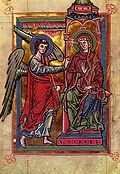
Magnificat
The Magnificat — also known as the Song of Mary or the Canticle of Mary — is a canticle frequently sung liturgically in Christian church services. It is one of the eight most ancient Christian hymns and perhaps the earliest Marian hymn...
antiphons used at Vespers
Vespers
Vespers is the evening prayer service in the Western Catholic, Eastern Catholic, and Eastern Orthodox, Anglican, and Lutheran liturgies of the canonical hours...
of the last seven days of Advent
Advent
Advent is a season observed in many Western Christian churches, a time of expectant waiting and preparation for the celebration of the Nativity of Jesus at Christmas. It is the beginning of the Western liturgical year and commences on Advent Sunday, called Levavi...
in various liturgical Christian
Christian
A Christian is a person who adheres to Christianity, an Abrahamic, monotheistic religion based on the life and teachings of Jesus of Nazareth as recorded in the Canonical gospels and the letters of the New Testament...
traditions.
Each antiphon is a name of Christ, one of his attributes mentioned in Scripture. They are:
- December 17: O Sapientia (O WisdomWisdomWisdom is a deep understanding and realization of people, things, events or situations, resulting in the ability to apply perceptions, judgements and actions in keeping with this understanding. It often requires control of one's emotional reactions so that universal principles, reason and...
) - December 18: O Adonai (O LordLordLord is a title with various meanings. It can denote a prince or a feudal superior . The title today is mostly used in connection with the peerage of the United Kingdom or its predecessor countries, although some users of the title do not themselves hold peerages, and use it 'by courtesy'...
) - December 19: O Radix Jesse (O Root of JesseTree of JesseThe Tree of Jesse is a depiction in art of the Ancestors of Christ, shown in a tree which rises from Jesse of Bethlehem, the father of King David; the original use of the family tree as a schematic representation of a genealogy...
) - December 20: O Clavis David (O Key of DavidDavidDavid was the second king of the united Kingdom of Israel according to the Hebrew Bible and, according to the Gospels of Matthew and Luke, an ancestor of Jesus Christ through both Saint Joseph and Mary...
) - December 21: O Oriens (O Dayspring)
- December 22: O Rex Gentium (O King of the nations)
- December 23: O Emmanuel (O God is with Us)
In the Roman Catholic tradition, the O Antiphons are sung or recited at Vespers
Vespers
Vespers is the evening prayer service in the Western Catholic, Eastern Catholic, and Eastern Orthodox, Anglican, and Lutheran liturgies of the canonical hours...
from December 17 to December 23 inclusive (but see note below on alternative English usage).
In the Church of England
Church of England
The Church of England is the officially established Christian church in England and the Mother Church of the worldwide Anglican Communion. The church considers itself within the tradition of Western Christianity and dates its formal establishment principally to the mission to England by St...
they have traditionally been used as antiphons to the Magnificat
Magnificat
The Magnificat — also known as the Song of Mary or the Canticle of Mary — is a canticle frequently sung liturgically in Christian church services. It is one of the eight most ancient Christian hymns and perhaps the earliest Marian hymn...
at Evening Prayer
Evening Prayer (Anglican)
Evening Prayer is a liturgy in use in the Anglican Communion and celebrated in the late afternoon or evening...
during this period, and although not printed in the Book of Common Prayer
Book of Common Prayer
The Book of Common Prayer is the short title of a number of related prayer books used in the Anglican Communion, as well as by the Continuing Anglican, "Anglican realignment" and other Anglican churches. The original book, published in 1549 , in the reign of Edward VI, was a product of the English...
, have long been part of secondary Anglican liturgical sources, such as the English Hymnal
English Hymnal
The English Hymnal was published in 1906 for the Church of England under the editorship of Percy Dearmer and Ralph Vaughan Williams. The preface to the hymnal began with the statement, "A collection of the best hymns in the English language." Much of the contents was used for the first time at St...
. More recently they have found a place in primary liturgical documents throughout the Anglican Communion, including the Church of England
Church of England
The Church of England is the officially established Christian church in England and the Mother Church of the worldwide Anglican Communion. The church considers itself within the tradition of Western Christianity and dates its formal establishment principally to the mission to England by St...
's Common Worship
Common Worship
Common Worship is the name given to the series of services authorised by the General Synod of the Church of England and launched on the first Sunday of Advent in 2000. It represents the most recent stage of development of the Liturgical Movement within the Church and is the successor to the...
liturgy
Liturgy
Liturgy is either the customary public worship done by a specific religious group, according to its particular traditions or a more precise term that distinguishes between those religious groups who believe their ritual requires the "people" to do the "work" of responding to the priest, and those...
.
Use of the O Antiphons also occurs in many Lutheran churches. In the Book of Common Worship
The Book of Common Worship of 1993
The Book of Common Worship of 1993 is the fifth liturgical book of the Presbyterian Church .With the reunion of the United Presbyterian Church and the Presbyterian Church , which took place in 1983, the need arose for a new liturgical book of the Presbyterian Church...
published by the Presbyterian Church (USA)
Presbyterian Church (USA)
The Presbyterian Church , or PC, is a mainline Protestant Christian denomination in the United States. Part of the Reformed tradition, it is the largest Presbyterian denomination in the U.S...
, the antiphons can be read as a praise litany at Morning or Evening Prayer.
The hymn
Hymn
A hymn is a type of song, usually religious, specifically written for the purpose of praise, adoration or prayer, and typically addressed to a deity or deities, or to a prominent figure or personification...
O come, O come, Emmanuel
O come, O come, Emmanuel
O come, O come, Emmanuel is a translation of the Latin text by John Mason Neale and Henry Sloane Coffin in the mid-19th century. It is a metrical version of a collation of various Advent Antiphons , which now serves as a popular Advent hymn...
(in Latin, Veni Emmanuel) is a lyrical paraphrase of these antiphon
Antiphon
An antiphon in Christian music and ritual, is a "responsory" by a choir or congregation, usually in Gregorian chant, to a psalm or other text in a religious service or musical work....
s.
The first letters of the titles taken backwards form a Latin acrostic
Acrostic
An acrostic is a poem or other form of writing in which the first letter, syllable or word of each line, paragraph or other recurring feature in the text spells out a word or a message. As a form of constrained writing, an acrostic can be used as a mnemonic device to aid memory retrieval. A famous...
of "Ero Cras" which translates to "Tomorrow, I will come", mirroring the theme of the antiphons.
Origin

A number of other antiphons were found in various medieval breviaries.
Analysis
The importance of the "O Antiphons" is twofold. First, each one is a title for the MessiahMessiah
A messiah is a redeemer figure expected or foretold in one form or another by a religion. Slightly more widely, a messiah is any redeemer figure. Messianic beliefs or theories generally relate to eschatological improvement of the state of humanity or the world, in other words the World to...
. Secondly, each one refers to the prophecy
Prophecy
Prophecy is a process in which one or more messages that have been communicated to a prophet are then communicated to others. Such messages typically involve divine inspiration, interpretation, or revelation of conditioned events to come as well as testimonies or repeated revelations that the...
of Isaiah
Isaiah
Isaiah ; Greek: ', Ēsaïās ; "Yahu is salvation") was a prophet in the 8th-century BC Kingdom of Judah.Jews and Christians consider the Book of Isaiah a part of their Biblical canon; he is the first listed of the neviim akharonim, the later prophets. Many of the New Testament teachings of Jesus...
of the coming of the Messiah. The Latin antiphons are from the Breviarium Romanum. The English versions, which are not always literal translations of the Latin, are from the Church of England's Common Worship liturgy. Biblical quotations are from the NRSV
New Revised Standard Version
The New Revised Standard Version of the Bible is an English translation of the Bible released in 1989 in the USA. It is a thorough revision of the Revised Standard Version .There are three editions of the NRSV:...
.
O Sapientia
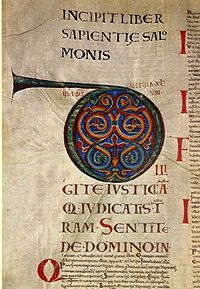
- O Sapientia, quae ex ore Altissimi prodiisti,
- attingens a fine usque ad finem,
- fortiter suaviterque disponens omnia:
- veni ad docendum nos viam prudentiae.
English:
- O Wisdom, coming forth from the mouth of the Most High,
- reaching from one end to the other mightily,
- and sweetly ordering all things:
- Come and teach us the way of prudence.
Isaiah had prophesied:
- "The spirit of the Lord shall rest on him, the spirit of wisdom and understanding, the spirit of counsel and might, the spirit of knowledge and the fear of the Lord. His delight shall be in the fear of the Lord."
- "[...] he is wonderful in counsel, and excellent in wisdom."
Also compare and
This prophecy is also relevant in that it describes the Messiah as "coming forth from the mouth of the Most High", which is very significant in light of the Christian doctrine, rooted in the first chapter of the Gospel of John, according to which Jesus Christ, the Messiah, is the Incarnate Word
Jesus Christ the Logos
In Christology, the conception that the Christ is the Logos has been important in establishing the doctrine of the divinity of Jesus Christ and his position as God the Son in the Trinity as set forth in the Chalcedonian Creed.The conception derives from the opening of the Gospel of John, commonly...
of God the Father.
O Adonai
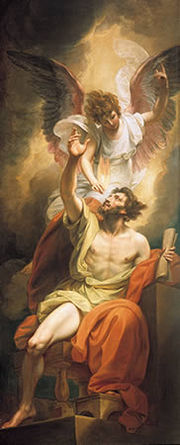
- O Adonai, et Dux domus Israel,
- qui Moysi in igne flammae rubi apparuisti,
- et ei in Sina legem dedisti:
- veni ad redimendum nos in brachio extento.
English:
- O Adonai, and leader of the House of Israel,
- who appeared to Moses in the fire of the burning bush
- and gave him the law on Sinai:
- Come and redeem us with an outstretched arm.
Isaiah had prophesied:
- "[...] but with righteousness he shall judge the poor, and decide with equity for the meek of the earth; he shall strike the earth with the rod of his mouth, and with the breath of his lips he shall kill the wicked. Righteousness shall be the belt around his waist, and faithfulness the belt around his loins."
- "For the Lord is our judge, the Lord is our ruler, the Lord is our king; he will save us."
Also compare and
O Radix Jesse
Latin:- O Radix Jesse, qui stas in signum populorum,
- super quem continebunt reges os suum,
- quem Gentes deprecabuntur:
- veni ad liberandum nos, jam noli tardare.
English:
- O Root of Jesse, standing as a sign among the peoples;
- before you kings will shut their mouths,
- to you the nations will make their prayer:
- Come and deliver us, and delay no longer.
Isaiah had prophesied:
- "A shoot shall come out from the stock of Jesse, and a branch shall grow out of his roots."
- "On that day the root of Jesse shall stand as a signal to the peoples; the nations shall inquire of him, and his dwelling shall be glorious."
Jesse
Jesse
Jesse, Eshai or Yishai, is the father of the David, who became the king of the Israelites. His son David is sometimes called simply "Son of Jesse" ....
was the father of King David, and Micah
Micah (prophet)
Micah, meaning “who is like Yahweh," was a prophet who prophesied from approximately 737-690 BC in Judah and is the author of the Book of Micah. He was a contemporary of the prophets Isaiah, Amos and Hosea and is considered one of the twelve minor prophets of the Tanakh . Micah was from...
had prophesied that the Messiah would be of the house and lineage of David and be born in David’s city, Bethlehem
Bethlehem
Bethlehem is a Palestinian city in the central West Bank of the Jordan River, near Israel and approximately south of Jerusalem, with a population of about 30,000 people. It is the capital of the Bethlehem Governorate of the Palestinian National Authority and a hub of Palestinian culture and tourism...
. Also compare , and .
O Clavis David
Latin:- O Clavis David, et sceptrum domus Israel;
- qui aperis, et nemo claudit;
- claudis, et nemo aperit:
- veni, et educ vinctum de domo carceris,
- sedentem in tenebris, et umbra mortis.
English:
- O Key of David and sceptre of the House of Israel;
- you open and no one can shut;
- you shut and no one can open:
- Come and lead the prisoners from the prison house,
- those who dwell in darkness and the shadow of death.
Isaiah had prophesied:
- "I will place on his shoulder the key of the house of David; he shall open, and no one shall shut; he shall shut, and no one shall open."
- "His authority shall grow continually, and there shall be endless peace for the throne of David and his kingdom. He will establish and uphold it with justice and with righteousness from this time onwards and for evermore."
- "...To open the blind eyes, to bring out the prisoners from the prison, and them that sit in darkness out of the prison house.".
O Oriens
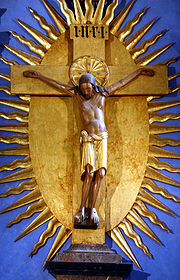
- O Oriens,
- splendor lucis aeternae, et sol justitiae:
- veni, et illumina sedentes in tenebris, et umbra mortis.
English:
- O Morning Star,
- splendour of light eternal and sun of righteousness:
- Come and enlighten those who dwell in darkness and the shadow of death.
(Note: A literal translation of the Latin yields "O Rising Sun", but the poetic "O Morning Star" is often preferred.)
Isaiah had prophesied:
- "The people who walked in darkness have seen a great light; those who lived in a land of deep darkness—on them light has shined."
Also compare and ; Ml 3,20
O Rex Gentium

- O Rex Gentium, et desideratus earum,
- lapisque angularis, qui facis utraque unum:
- veni, et salva hominem,
- quem de limo formasti.
English:
- O King of the nations, and their desire,
- the cornerstone making both one:
- Come and save the human race,
- which you fashioned from clay.
Isaiah had prophesied:
- "For a child has been born for us, a son given us; authority rests upon his shoulders; and he is named Wonderful Counsellor, Mighty God, Everlasting Father, Prince of Peace."
- "He shall judge between the nations, and shall arbitrate for many peoples; they shall beat their swords into ploughshares, and their spears into pruning-hooks; nation shall not lift up sword against nation, neither shall they learn war anymore."
Also compare and
O Emmanuel
Latin:- O Emmanuel, Rex et legifer noster,
- exspectatio Gentium, et Salvator earum:
- veni ad salvandum nos, Domine, Deus noster.
English:
- O Emmanuel, our king and our lawgiver,
- the hope of the nations and their Saviour:
- Come and save us, O Lord our God.
Isaiah had prophesied:
- "Therefore the Lord himself will give you a sign. Look, the young woman is with child and shall bear a son, and shall name him Immanuel."
(Emmanuel means God is with us).
Alternative English Usage
Although the antiphons and dates shown above have been fairly universally recognised throughout western Christendom, an alternative English medieval practice arose of moving all of the antiphons forward by one day (commencing therefore on 16 December) and adding an additional (eighth) antiphon on 23 December, with the acrostic thus becoming Vero cras, "truly, tomorrow". This is the antiphon O Virgo virginum (O Virgin of virgins), with the following text:Latin:
- O Virgo virginum, quomodo fiet istud?
- Quia nec primam similem visa es nec habere sequentem.
- Filiae Jerusalem, quid me admiramini?
- Divinum est mysterium hoc quod cernitis.
English:
- O Virgin of virgins, how shall this be?
- For neither before thee was any like thee, nor shall there be after.
- Daughters of Jerusalem, why marvel ye at me?
- The thing which ye behold is a divine mystery.
Given the English origins of this alternative, it has traditionally been the version used in the Church of England
Church of England
The Church of England is the officially established Christian church in England and the Mother Church of the worldwide Anglican Communion. The church considers itself within the tradition of Western Christianity and dates its formal establishment principally to the mission to England by St...
(including Canterbury Cathedral
Canterbury Cathedral
Canterbury Cathedral in Canterbury, Kent, is one of the oldest and most famous Christian structures in England and forms part of a World Heritage Site....
) until modern times, and is the version printed in traditional Church of England liturgical sources including the English Hymnal
English Hymnal
The English Hymnal was published in 1906 for the Church of England under the editorship of Percy Dearmer and Ralph Vaughan Williams. The preface to the hymnal began with the statement, "A collection of the best hymns in the English language." Much of the contents was used for the first time at St...
and New English Hymnal
New English Hymnal
The New English Hymnal is a hymn book and liturgical source, aimed towards the Church of England, first published in 1986. It was published by the Canterbury Press . The copyright is held by The English Hymnal Company Limited. It is a successor to, and published in the same style as, the 1906...
. From 2000, however, the Church of England
Church of England
The Church of England is the officially established Christian church in England and the Mother Church of the worldwide Anglican Communion. The church considers itself within the tradition of Western Christianity and dates its formal establishment principally to the mission to England by St...
appears to have taken an official step away from English medieval practice towards the more universal norm, as Common Worship
Common Worship
Common Worship is the name given to the series of services authorised by the General Synod of the Church of England and launched on the first Sunday of Advent in 2000. It represents the most recent stage of development of the Liturgical Movement within the Church and is the successor to the...
makes provision for the sevenfold version of the antiphons, and not the eightfold version. This antiphon also appears in the Graduale of the Premonstratensian
Premonstratensian
The Order of Canons Regular of Prémontré, also known as the Premonstratensians, the Norbertines, or in Britain and Ireland as the White Canons , are a Catholic religious order of canons regular founded at Prémontré near Laon in 1120 by Saint Norbert, who later became Archbishop of Magdeburg...
Order and it is still used by those monasteries.
Antiphons on the Benedictus
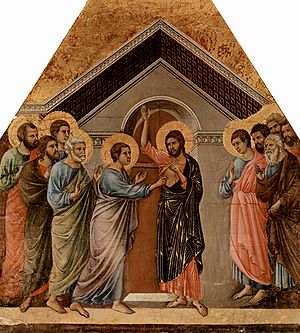
Lauds
Lauds is a divine office that takes place in the early morning hours and is one of the two major hours in the Roman Catholic Liturgy of the Hours. In the Eastern Orthodox tradition, it forms part of the Office of Matins...
, on December 21 and 23, also relating to the theme of the upcoming birth of Christ. The first, due to the feast of St Thomas
Thomas the Apostle
Thomas the Apostle, also called Doubting Thomas or Didymus was one of the Twelve Apostles of Jesus. He is best known for questioning Jesus' resurrection when first told of it, then proclaiming "My Lord and my God" on seeing Jesus in . He was perhaps the only Apostle who went outside the Roman...
falling on December 21, is traditionally used instead in the commemoration of the feria. With the transference of this feast to July 3 in the revised calendar, these are again used in the Liturgy of the Hours
Liturgy of the hours
The Liturgy of the Hours or Divine Office is the official set of daily prayers prescribed by the Catholic Church to be recited at the canonical hours by the clergy, religious orders, and laity. The Liturgy of the Hours consists primarily of psalms supplemented by hymns and readings...
as antiphons. The Monday through Saturday which fall on the days of the O Antiphons also have their own antiphons for the psalms of Lauds, rather than repeating the antiphons of the previous Sunday, as is otherwise done in Advent.
December 21
Nolite timere: quinta enim die veniet ad vos Dominus noster.- Fear not, for on the fifth day our Lord will come to you.
December 23
Ecce completa sunt omnia, quae dicta sunt per Angelum de Virgine Maria.- Behold, all things are fulfilled, which were spoken by the Angel to the Virgin Mary.
Media
- Sapientia, Adonai, Radix Jesse, Clavis David, Oriens, Rex Gentium, Emmanuel: "O Antiphons" as interactive hypermedia (Shockwave required) at the BinAural Collaborative Hypertext.
External links
- A reflection on the O Antiphons from Anglicans OnlineAnglicans onlineAnglicans Online is an unofficial weekly news magazine of the Anglican Communion. Its editorial staff is private and unaffiliated. A project of the Society of Archbishop Justus founded in 1994, AO includes more than 30,000 links and has more than 250,000 readers. calls it 'a kind voice in what...
- The Advent Antiphons, by A.C.A. Hall, 1914 commentary and paraphrase.
- Saunders, Fr. William, What are the O Antiphons?
- Stewart, Andrew
- Umilta Website on Julian of Norwich

